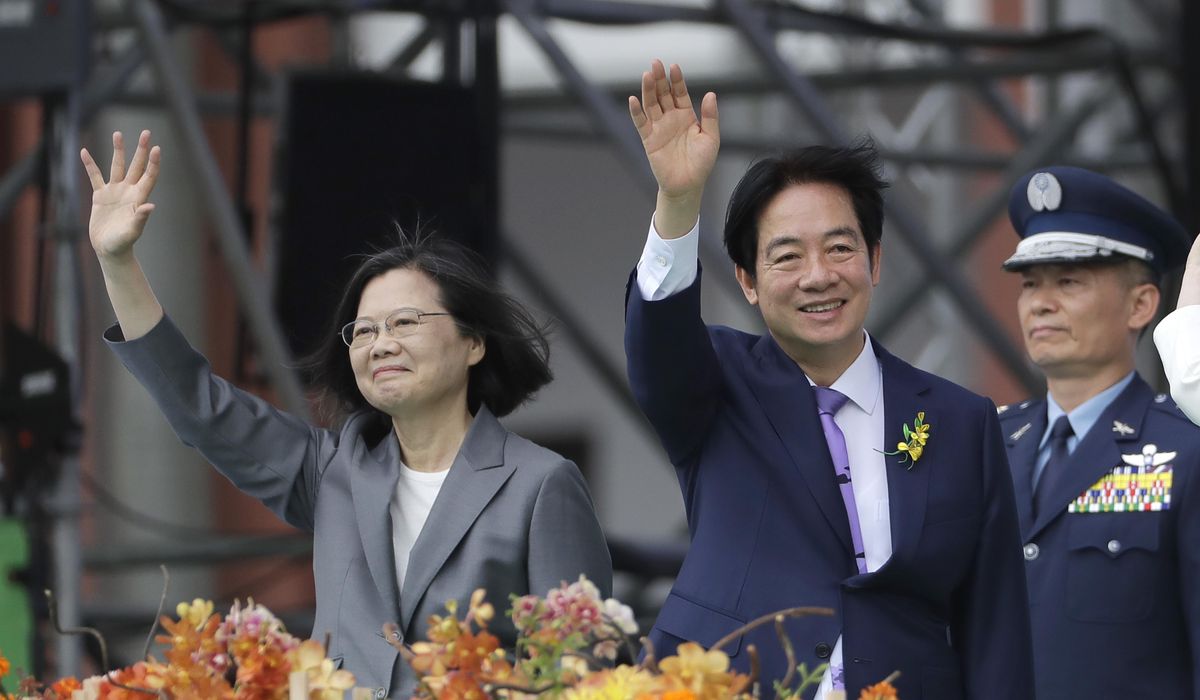


SEOUL, South Korea – The island democracy of Taiwan faced internal demonstrations and major new military drills from communist China on Friday, just days into the tenure of newly inaugurated President William Lai Ching-te.
Chinese military units conducted exercises in the waters of the Taiwan Strait, and the skies above it, in a move that seems designed to try to intimidate the new president. But such Chinese intimidation is only one of Mr. Lai’s pressing concerns.
In the opposition-controlled Legislative Yuan, a bill is pending that Mr. Lai’s Democratic Progressive Party and tens of thousands of citizen protesters believe undermines democratic governance.
Mr. Lai, who had called for Taiwanese independence early in his political career, was elected in January and inaugurated on May 20. Given Beijing’s risks and the pressure from democratic partners who adhere to the “One China” policy, few expect him to formally declare independence.
But he did make clear in his inauguration speech his view on Taipei’s relations with Beijing, which claims the democratically governed island as a part of China.
Taiwan and China “are not subordinate to each other,” Mr. Lai said in the address. “All our political parties ought to oppose annexation and protect sovereignty.”
Former U.S. Secretary of State Mike Pompeo, visiting the island this week, called for the recognition of Taiwanese independence.
“It is time for the United States to lead boldly, act justly, and recognize Taiwan as the independent and sovereign nation it truly is,” he said.
Those comments sparked fury in China, which slammed both Taiwan and the U.S.
“Lai’s speech stubbornly followed the ‘Taiwan independence’ stance, wantonly advocated separatism, incited cross-Strait confrontation and sought independence by relying on foreign support and by force,” a spokesperson of the Chinese Consulate General in New York said on May 21, one day after Lai’s inauguration. “The wrongful words and actions of a handful of American political figures violate the one-China principle and basic norms … and damage the peace and stability in the Taiwan Strait.”
Strangulation tactics drilled
Beijing’s “Joint Sword 2024A” drills, designed to surround Taiwan, began Thursday and are set to finish Friday.
“Integrated operations inside and outside the island chain are being conducted to test … capabilities to jointly take control of battlefield and launch joint strikes, and to seize control of crucial areas,” the Eastern Theater Command of the Chinese People’s Liberation Army announced Friday, per Beijing’s Xinhua news agency.
According to Taiwan’s Defense Ministry, 49 Chinese aircraft and 19 warships operated around Taiwan on Friday morning. Another 35 aircraft had crossed the flashpoint Median Line in the Taiwan Strait, Taiwanese officials said.
In addition, seven Chinese Coast Guard ships conducted drills near Taiwan’s offshore islands. Though non-lethal, Beijing’s Coast Guard is a frontline force used to press Beijing’s claims on disputed islands, shoals, and fishing zones in regional waters.
Taiwanese forces monitored the situation and were “responding accordingly,” Taipei’s Defense Ministry said on social media Friday. China’s exercises, “which highlight its hegemony mindset, have undermined regional peace and stability,” the ministry added.
On Thursday night, three Taiwanese warships were spotted leaving their moorings and heading for the open sea.
Maps posted by Taiwan’s Defense Ministry show that Chinese air assets are operating north, west, and southwest of the island. Other maps posted by open-source intelligence groups showed maritime assets operating at points all around the island, including off its Pacific-facing east coast.
The “strangulation” deployment drills include two tactics feared by Taiwanese officials. One is a naval blockade of the island, possibly leading to the second: An all-out attack by Chinese troops.
Some fear that Chinese forces could mass for drills and then switch immediately from exercise footing to war footing. Russia followed a similar blueprint in the run-up to its invasion of Ukraine in February 2022.
But there appear to have been no unusual movements of major Chinese forces or assets on the mainland.
Political storms rage on the streets, in the Yuan
Tens of thousands of people have demonstrated this week in Taipei. Some chanted: “If there is no democracy, there is no Taiwan.”
Their ire has been sparked by a pending bill that has also ignited brawls in the Legislative Yuan. The bill is being promoted by the conservative opposition, the Kuomintang, or KMT.
The KMT was originally deeply opposed to the Chinese Communist Party during the Chinese Civil War, which ended in communist victory and the flight of the KMT to Taiwan in 1948. In recent years, it has morphed into a party that many observers say is more Beijing-friendly than Mr. Lai’s DPP.
In the house, the KMT enjoys the support of the Taiwan People’s Party, or TPP, making the DPP a minority. It is the first time in 16 years that the Yuan has not had a clear majority, a situation Mr. Lai has characterized as a “new political landscape.”
Protesters, as well as some legal scholars, contend that the proposed bill lacks checks and balances, and would undermine the president, his cabinet, and even Taiwanese democracy itself.
As it stands, it would grant legislators the right to question or demand data from any members of the government and military.
Some also fret over the posture of the current head of the legislature, Han Kuo-yu, due to his past contacts with Beijing officialdom.
• Andrew Salmon can be reached at asalmon@washingtontimes.com.
